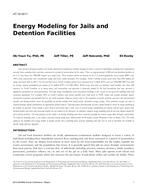
AT-15-C011 — Energy Modeling for Jails and Detention Facilities
Jail and local detention facilities are locally administered confinement facilities designed to house a variety of individuals including those immediately arrested, those awaiting trial, and those sentenced to a period of incarceration by the courts. There are approximately 3,200 jail and detention facilities in the U.S. that house over 700,000 inmates on a daily basis. These numbers mirror an increase in the U.S. prison population rate of nearly 400% since 1983. Jails and prisons have considerable energy and water utility demands. For example, North Carolina prisons spent more than $48 million for energy and water bills in 2011. For the last three years, North Carolina prisons have consumed over 2 billion BTUs per year (586,000 kWh/yr) with an average annual consumption per inmate of 52 million BTUs (15,300 kWh). While many local jails are relatively small facilities (less than 100 inmates), in North Carolina, as in many states, jail construction and operation is primarily funded by the local jurisdiction and may represent a significant expenditure for local governments. The high energy consumption of jail and prison buildings is due in part to the age of the building stock and associated equipment. For example, 60% of North Carolina state prison facilities were built prior to 1990. Safety and security demands require construction materials and methods that are not easily insulated. However, factors such as the continuous need for electricity and heat and self-contained laundry and dining facilities create the possibility for facility retrofits that could provide substantial energy savings. These potential savings can only be realized through capital expenditures on appropriate facility projects. Typically project prioritization of scarce capital would be based on energy modeling of the facility in question. Even though a great deal of macro-level data exists, such as overall energy consumption per inmate and per gross square foot, detailed facility level data and associated models are not evident in the literature. In addition, common energy modeling tools do not have default models for jail or prison facilities. The main purpose of this study is to develop modeling tools that accurately quantify the various energy flows through a jail facility. To verify the modeling tools, a case study is presented using energy data collected from the Watauga County Detention Center in Boone, NC. The study compares the building level energy models to facility specific data, providing more accurate modeling tools that can be used to determine the viability of specific energy efficiency upgrades.
Product Details
- Published:
- 2015
- Number of Pages:
- 8
- Units of Measure:
- Dual
- File Size:
- 1 file , 740 KB
- Product Code(s):
- D-AT-15-C011
- Note:
- This product is unavailable in Russia, Belarus


